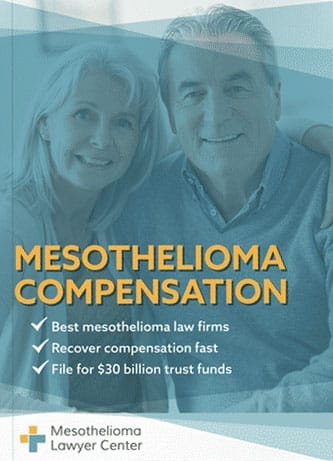Minnesota mesothelioma lawyers help victims of asbestos illnesses fight for justice. In addition to farms and lumber mills, Minnesota is home to many factories, mines, and food processing plants, most of which once used asbestos and exposed workers
If you or a loved one suffer from mesothelioma, asbestos-related lung cancer, or asbestosis, keep in mind that you may be entitled to significant compensation for pain, suffering, lost wages, trauma, and much more. We invite you to fill out our form today for a free Financial Compensation Packet, filled with information about experienced mesothelioma lawyers in Minnesota, how to get paid in 90 days, how to file an asbestos trust fund claim, and much more.
Understanding the timeline for receiving financial compensation is crucial. The length of time to recover your compensation will depend on the type of case you file:
- Mesothelioma lawsuits can take several months to a year or longer to resolve. This duration largely hinges on the asbestos product manufacturer’s willingness to accept responsibility.
- Trust fund claims typically conclude more swiftly, ranging from a few weeks to a few months.
- VA claims are generally processed within an average of three to four months.
By recognizing these timelines, you can better prepare for the journey ahead, ensuring you pursue the most efficient path to securing the compensation you rightfully deserve.


FREE Financial Compensation Packet
- Info on law firms that will recover your HIGHEST COMPENSATION
- Learn how to get paid in 90 days
- File for your share of $30 billion in trust funds
We offer help in all cities and towns in Minnesota, such as:
Minneapolis, St. Paul, Rochester, Bloomington, Duluth, Brooklyn Park, Plymouth, Woodbury, Eagan, Maple Grove, Eden Prairie Coon Rapids, Burnsville, Blaine, Lakeville, St. Cloud, Minnetonka, Apple Valley, Edina, St. Louis Park, Mankato,Maplewood, Moorhead, Shakopee, Richfield, Cottage Grove, Roseville, Inver Grove Heights, Andover, Brooklyn Center, Savage, Oakdale, Winona, Fridley, Shoreview, Owatonna, Austin, Ramsey, Chaska, White, Bear Lake, Chanhassen, Prior Lake, Champlin, Faribault, Elk River, Crystal, Rosemount, Hastings, New Brighton, Farmington, Golden Valley, Lino Lakes, New Hope, South St. Paul, West St. Paul, Willmar, Columbia Heights, Northfield, Forest Lake, Stillwater, Albert Lea, Hopkins, Anoka, St. Michael, Red Wing, Hibbing, Buffalo City, Ham Lake, Bemidji, Robbinsdale, Hutchinson, Otsego, Sartell, Marshall, Hugo, Brainerd, North Mankato, New Ulm, Fergus Falls, Sauk, Rapids City, Monticello, Worthington, Vadnais Heights, Mounds View, Cloquet, East Bethel, North St. Paul, Alexandria City, St. Peter, Mendota Heights, White Bear, Waconia, Rogers City, Grand Rapids, Fairmont, Big Lake, North Branch, Little Canada, Arden Hills, Hermantown, and more.
Understanding Mesothelioma and Its Causes
Mesothelioma is a rare but aggressive cancer primarily affecting the lining of the lungs, abdomen, or heart. Its insidious nature is underscored by the fact that symptoms may not manifest until decades after initial exposure. This makes early detection challenging and often contributes to poor prognoses.
What Causes Mesothelioma?
The primary culprit behind mesothelioma is asbestos exposure. Asbestos is a naturally occurring mineral once lauded for its heat resistance and durability, leading to its widespread use in various industries. Unfortunately, prolonged exposure to asbestos fibers—a hazard particularly prevalent in construction, shipbuilding, and manufacturing sectors—initiates the dangerous chain of events that can culminate in mesothelioma.
- Historical Negligence: Companies involved in asbestos production and manufacturing were historically aware of its health risks. However, many chose to hide these dangers to protect their interests.
- Regulatory Efforts: In 1989, the Environmental Protection Agency (EPA) sought to ban asbestos due to the overwhelming evidence of its health risks. This ban, however, was partially overturned in 1991, allowing limited use under stricter regulations.
Though asbestos is less prevalent today, its legacy endures. Awareness and regulation have improved, yet mesothelioma remains a poignant reminder of the mineral’s deadly potential.
Understanding the link between asbestos and mesothelioma is crucial, as efforts continue globally to limit exposure and push for safer alternatives.
Why Is Asbestos Still Used Despite Its Health Risks?
Despite the well-documented dangers of asbestos, its usage continues in certain products today. This persistence stems from a complex regulatory and economic background.
In the late 1980s, significant steps were taken to eliminate asbestos. The Environmental Protection Agency (EPA) sought an outright ban on this hazardous material due to its indisputable link to mesothelioma and other serious health conditions. However, in 1991, a federal appeals court overturned this ban.
Key Reasons for Continued Use:
- Regulatory Overturn: The reversal of the ban allowed asbestos usage to continue but with stricter regulations. This meant that safety standards were improved, but the option to use asbestos still legally exists.
- Specific Applications: Asbestos possesses unique properties like heat resistance and strength, which make it irreplaceable in certain industrial applications. It’s particularly prevalent in construction materials where these attributes are crucial.
- Economic Factors: The cost of replacing asbestos with other materials can be high. Industries that rely on its qualities might find alternatives economically unviable, thus continuing its use under controlled regulations.
- Existing Products: Many older buildings still contain asbestos. While new installations might be limited, maintaining and handling existing asbestos materials requires ongoing use.
Asbestos remains in circulation primarily due to a legal framework that allows for regulated usage, coupled with its cost-effective and unique functional attributes in specific sectors.
Minnesota Asbestos Facts

- Nearly 6,500 people died from diseases related to asbestos exposure in Minnesota between 1999 and 2017.
- Of those deaths, 1,176 resulted from mesothelioma.
- Asbestosis accounted for 469 deaths.
- The rest of the deaths were from asbestos-related lung cancer.
- The highest concentration of asbestos deaths was in Hennepin County.
Why Should I Sue for Mesothelioma?
If you have been diagnosed with mesothelioma, you have a right to take legal action. Most people sue for mesothelioma to collect compensation. The companies responsible for exposing you to asbestos can be held liable for resulting medical and other expenses.
How Can Mesothelioma Victims Recover Compensation Through Multiple Sources?
Recovering compensation as a mesothelioma victim involves pursuing various avenues to secure financial relief. Understanding these options can significantly impact the support received during treatment and recovery.
Legal Claims
- Asbestos Trust Funds: Many companies responsible for asbestos exposure have established trust funds. These are specifically designated to compensate individuals affected by mesothelioma. Victims can file claims with these trusts, which are designed to streamline the process and offer swift compensation.
- Lawsuits: Filing a personal injury lawsuit against the companies responsible for asbestos exposure is another route. This typically involves pursuing either a settlement or a jury award. Successful lawsuits can cover medical costs, lost wages, and other damages.
- Wrongful Death Claims: If a loved one has succumbed to mesothelioma, families may file wrongful death claims. This can provide compensation for funeral expenses, medical bills incurred, and loss of companionship or financial support.
Government Benefits
Government programs can also offer assistance:
- Veterans’ Benefits: Veterans exposed to asbestos during military service may be eligible for benefits through the Department of Veterans Affairs (VA). This includes potential compensation for disabilities linked to mesothelioma.
- Social Security Disability: Mesothelioma victims may qualify for Social Security Disability Insurance (SSDI), which provides monthly benefits to those unable to work due to their condition.
Settlements
Many cases are resolved through out-of-court settlements. This can provide a faster resolution than a lengthy trial, offering victims and their families immediate financial relief and certainty.
Insurance Claims
Health insurance policies, including private insurance and Medicare, can cover significant portions of treatment costs. Additionally, life insurance policies might offer accelerated benefits for those with terminal illnesses, providing upfront financial support.
By exploring these various channels, mesothelioma victims can access a comprehensive range of support designed to alleviate the financial burdens associated with their condition.
What Types of Asbestos Claims Am I Eligible to Make in Minnesota?

There is more than one way to seek compensation for a mesothelioma diagnosis. A lawyer can explain these options and help you determine which one or more are best for you:
- Personal Injury Lawsuit. Asbestos illnesses are often negligent, which means you can file a personal injury lawsuit to hold asbestos companies liable. Most asbestos lawsuits settle out of court.
- Wrongful Death Lawsuit. For the death of a loved one from mesothelioma, you may be able to recover damages with a wrongful death lawsuit.
- Asbestos Trust Fund Claim. Bankrupt asbestos companies cannot be sued, but you can still seek compensation from them. Most were required to set up asbestos trust funds, which currently still have about $30 billion available to compensate victims.
- VA Benefits Claim. If you are a veteran with mesothelioma, you may be eligible for monthly disability compensation and other benefits. You must be able to connect your illness to asbestos exposure during military service.
Finding a Minnesota Mesothelioma Lawyer
Rely on top-rated Minnesota mesothelioma lawyers for the best chance of getting the compensation you deserve. Look for a lawyer with expertise and experience handling and winning asbestos cases.
An experienced mesothelioma attorney can offer invaluable assistance in a variety of asbestos-related matters. These include:
- Mesothelioma
- Lung cancer due to asbestos exposure
- Asbestosis
- Wrongful death claims
- Asbestos-related pleural disease
- Occupational asbestos exposure
They should be local but have a wider reach. Only large, nationwide firms have the adequate resources needed to prove your mesothelioma case. They use investigators and medical experts to prove which companies exposed you to asbestos and that the exposure caused your illness.
Consider the impressive track record some firms boast, with recoveries reaching millions of dollars for affected clients. Imagine a jury awarding over $4 million for a brief summer job as an asbestos insulator, or a $5 million settlement prior to trial for a retired pipe fitter. These outcomes illustrate the potential of skilled legal representation.
Make sure the lawyer you choose offers a free initial consultation and contingency payment. You shouldn’t have to pay anything until they win. Leveraging their expertise could lead to significant compensation, helping to secure your future and hold responsible parties accountable.
How to File a Mesothelioma Lawsuit in Minnesota
Filing a mesothelioma lawsuit in Minnesota requires understanding the legal landscape and following several steps to ensure your case is handled effectively.
1. Select the Right Legal Representation
Choosing a lawyer with extensive experience in mesothelioma cases is crucial. Look for a law firm that specializes in asbestos-related lawsuits and has a proven track record in Minnesota courts. These attorneys should be familiar with the state-specific procedures and have a history of significant recoveries for their clients.
2. Gather Essential Documentation
Collect all relevant documentation to support your case. This includes medical records confirming your diagnosis, details of your work history that indicate asbestos exposure, and any other proof linking your condition to asbestos contact. An experienced lawyer will guide you in compiling this information comprehensively.
3. File the Lawsuit in the Appropriate Jurisdiction
Minnesota is one of the leading states for filing mesothelioma claims because of its favorable laws and experienced judiciary in these matters. Consult with your attorney to file your lawsuit in the jurisdiction best suited to your case—this often involves considering where exposure occurred or where the responsible companies are located.
4. Engage in the Discovery Process
Once your lawsuit is filed, both parties will engage in discovery. This phase allows for the exchange of evidence, including depositions and document requests. Your attorney will manage this process, building a strong case to support your claim.
5. Consider Settlement Offers or Prepare for Trial
Many mesothelioma cases are settled before reaching trial. Your attorney will negotiate on your behalf, aiming for a fair settlement. If a satisfactory agreement isn’t achieved, be prepared to go to trial. Your lawyer will provide guidance and representation to pursue the best possible outcome.
How to Prove Asbestos Caused Your Mesothelioma Diagnosis
Understanding the Connection
First, it’s crucial to understand that asbestos exposure is the leading cause of mesothelioma. This means that demonstrating a link between your exposure to asbestos and your diagnosis is critical for a successful case. Here’s how you can establish that connection effectively.
Collecting Essential Evidence
1. Medical Records: Your diagnosis is the foundation of your case. Obtain detailed medical records that confirm mesothelioma as your condition. These records will form the cornerstone of your claim.
2. Employment History: Compile documentation of your work history that shows where and when you were exposed to asbestos. This might include job titles, duties, and locations of employment where asbestos was present.
3. Witness Testimonies: Colleagues or other individuals who can testify about working conditions and asbestos exposure can provide valuable testimonies supporting your case.
Leveraging Expert Resources
You don’t need to gather all the proof alone. Experienced attorneys specializing in asbestos-related cases often have access to extensive databases containing historical evidence of asbestos use. These resources might include:
- Internal Memos and Purchase Records: These documents can show that companies were aware of asbestos hazards.
- Regulatory Documentation: Reports from agencies like OSHA or the EPA can provide evidence of known risks and regulations related to asbestos use.
Legal Guidance and Support
Consulting with a knowledgeable lawyer can significantly enhance your ability to prove your case. Legal experts can help you navigate the complexities of asbestos exposure laws and utilize their resources to strengthen your claim. This experienced guidance can be crucial in identifying the companies responsible and ensuring you have the best chance of a successful outcome.
How Long Do Asbestos Lawsuits Typically Take?
Asbestos lawsuits can vary significantly in duration, often depending on several factors. Generally, these cases may take several months to a few years from initiation to resolution.
Key Factors Influencing Duration:
- Court System and Jurisdiction: The speed of your case can heavily depend on the efficiency of the court system in your specific jurisdiction. Some states have specialized courts aimed at expediting these cases, while others may have a backlog.
- Complexity of the Case: Cases can differ in complexity based on the evidence required, the number of companies involved, and the specific legal arguments. More complex cases could naturally extend the timeline.
- Pre-Trial Settlements: Many asbestos lawsuits settle before ever reaching trial. Negotiations can take months, but if a settlement is reached early, it could significantly shorten the case duration.
- Trial and Verdict: If your case goes to trial, this stage can add several months or even years, depending on the court schedule, legal proceedings, and any potential appeals.
Steps in the Process:
- Filing the Lawsuit: The first step is to file a formal complaint. This action initiates the legal process and serves as the foundation for your claim.
- Discovery Phase: During this phase, both parties gather evidence. This stage can be lengthy due to the volume and complexity of documents reviewed.
- Settlement Negotiations: Before trial, both sides may engage in negotiations to resolve the matter outside the courtroom.
- Trial: If a settlement is not reached, the case proceeds to trial, which can extend the timeline significantly.
- Appeals: In some cases, either party may appeal the decision, adding more time to the process.
Quick Tip:
To navigate this lengthy process efficiently, it’s crucial to consult with an attorney who specializes in asbestos litigation as soon as possible. Their expertise is invaluable in managing timelines and ensuring you meet all necessary legal deadlines.
By understanding these aspects, you can better prepare for the trajectory of an asbestos lawsuit and engage proactively in the process.
Final Thoughts
Filing a mesothelioma lawsuit in Minnesota requires diligent preparation and expert legal assistance. The state’s legal system is well-equipped to handle these claims, offering victims and their families a meaningful chance to secure compensation. By working with a qualified attorney and following the necessary steps, you can pursue justice and financial relief.
Understanding the Costs of Hiring an Minnesota Mesothelioma Lawyer
When considering legal representation for mesothelioma claims in Minnesota , it’s crucial to understand the financial aspects involved. Here’s a breakdown of what you can expect:
- Contingency Fee Basis: Many mesothelioma lawyers in Minnesota work on a contingency fee arrangement. This means you won’t need to pay any upfront or hourly legal fees. The attorney only gets paid if you receive a settlement or a favorable court award.
- Success-Based Payment: Your lawyer’s fees are typically a percentage of the compensation they recover for you. This success-based approach aligns your interests with those of your attorney, as they are incentivized to maximize your compensation.
- Free Initial Consultation: Almost all Minnesota mesothelioma attorneys offer a free consultation. This meeting is an opportunity to discuss your case without any obligation, allowing you to explore your legal options and understand the potential outcomes before committing financially.
- Transparency in Fees: Reputable attorneys will provide clear, detailed information about their fee structure upfront, so you know exactly what to expect if your case is successful.
This financial structure is designed to minimize your risk, ensuring you can pursue justice and compensation without additional financial burden.
What Experience Do Minnesota Mesothelioma Lawyers Have with Asbestos-Exposure Cases?
When it comes to handling asbestos-exposure cases, Minnesota mesothelioma lawyers are equipped with substantial experience and expertise. These professionals have collectively spent decades championing the rights of victims suffering from asbestos-related illnesses, such as mesothelioma.
With over 100 years of combined experience, these attorneys are not only seasoned in legal representation but have also demonstrated outstanding success in securing compensation for their clients. This extensive track record includes recovering billions of dollars in settlements and verdicts for individuals and families impacted by asbestos exposure.
Why Choose Experienced Mesothelioma Lawyers?
- Proven Track Record: Hundreds of cases are filed each year under their guidance, showcasing their proficiency in navigating complex legal landscapes.
- Specialized Knowledge: Given their focus on mesothelioma claims, these lawyers understand the intricacies involved in asbestos litigation.
- Client-Centric Approach: They prioritize the well-being of their clients, ensuring that each case is handled with care, precision, and dedication.
Choosing experienced mesothelioma lawyers in Minnesota means opting for a team that has consistently delivered results and fought tirelessly for justice on behalf of those affected by asbestos exposure.
Minnesota asbestos attorneys have garnered numerous accolades for their dedication and expertise in handling asbestos-related cases. These lawyers have been acknowledged by prestigious organizations, reflecting their commitment to obtaining justice for those affected by asbestos exposure. Here’s a highlight of some noteworthy recognitions:
- Super Lawyers: Celebrating attorneys who demonstrate excellence in their field.
- National Trial Lawyers Top 100: Recognizes the top trial lawyers across the nation.
- Lawyers of Distinction – Personal Injury: Distinguishes exceptional personal injury attorneys.
- The National Academy of Personal Injury Attorneys Top 10 Under 40: Honors young and talented personal injury lawyers in Minnesota .
- Million Dollar Advocates Forum: Reserved for those who have secured million-dollar verdicts or settlements.
- America’s Top 100 Attorneys – Lifetime Achievement: Acknowledges lifetime dedication and exemplary legal service.
These awards highlight the significant achievements and the level of trust clients can place in these attorneys. Each recognition underscores their expertise and the impact they have made in the realm of asbestos litigation.
Examples of Successful Mesothelioma Case Recoveries in Minnesota
Minnesota has witnessed several noteworthy mesothelioma case recoveries. These cases highlight the significant compensation obtained for individuals affected by asbestos exposure.
- Local Brewery Turbine Operator: A notable recovery involved $2,000,000 for a local brewery power plant worker. The operator developed mesothelioma after prolonged exposure to asbestos throughout his career.
- Northern Iowa Plastic Business Owner: Another case resulted in a $2,000,000 recovery for a plastic molding business owner. This compensation came from litigation against manufacturers and suppliers of resin materials linked to his condition.
- Retired Twin Cities Pipefitter: A retired pipefitter from the Twin Cities received $3,000,000. He was diagnosed with mesothelioma in 2019 due to asbestos exposure from the 1970s to the 1980s.
- Power Plant Construction Worker: A verdict exceeding $4,000,000 was secured for a client who developed mesothelioma. The exposure occurred during the late 1950s while working with asbestos-containing materials at a power plant.
- Retired CPA and Asbestos Insulator: In a case involving a retired certified public accountant, a $4,600,000 jury award was granted for asbestos exposure from a single summer job in the late 1950s.
- Northern States Power Worker: A $4,600,000 jury award was affirmed by the Minnesota appellate courts for a worker affected by asbestos in a gasket manufacturer case.
- Minneapolis Pipe Fitter: In 2021, over $5,000,000 was recovered for a retired Minneapolis pipe fitter. The case involved manufacturers of asbestos-laden equipment like steam traps, boilers, and gaskets.
- Pipefitter at Refinery: A substantial $8,050,000 jury verdict was achieved for a pipefitter exposed at a refinery. This case underscores the profound impact of asbestos on workers’ health.
These recoveries reflect Minnesota’s commitment to securing justice and compensation for victims of asbestos exposure. Each case stands as a testament to the resilience and determination of those affected by mesothelioma, seeking accountability from responsible parties.
How Was I Exposed to Asbestos in Minnesota?
Most people with mesothelioma were exposed to asbestos on the job. Some of Minnesota’s most important industries and employers used asbestos for decades, putting workers at risk of exposure.
Minnesota’s geographic location in the upper Midwest is well-suited for mining, agriculture, and forestry, the state’s traditional economic drivers since Americans first settled it in the early 19th century.
Located next to the Great Lakes region and at the edge of the Great Plains, Minnesota still relies heavily on farming and logging.
Despite its rural history, the state has not been immune from asbestos health issues. Several industries have been around in Minnesota since the 19th century and used asbestos for decades:
- Ore mining
- Agricultural equipment
- Fur trapping and processing
- Logging
Asbestos is a family of six naturally-occurring minerals that are fibrous, resist chemical reactions, electrical charges, fire, and high temperatures.
Starting in the late 19th century, these beneficial properties appealed to a variety of industries operating in Minnesota:
- Power generation
- Construction
- Factories
- Steel mills
Mining and Asbestos in Minnesota
Minnesota was once renowned for its large deposits of soft ore and provided much of the world’s iron well into the 20th Century.
Much of the top-quality ore is depleted, yet the state still provides three-quarters of the iron ore used in the U.S. Miners extract tons of iron from taconite, a sedimentary rock that bears iron mixed with carbonate, chert, or quartz.
Though mining creates jobs and income for Minnesotans, extracting and processing minerals exposes miners and other workers to asbestos. The extraction and grinding of iron ore and taconite stir asbestos fibers and introduce them into the air.
Reserve Mining Company processed taconite in Silver Bay, near Duluth. In the 1970s, asbestos was found in Duluth’s drinking water. The company was found to have dumped mining tailings in Lake Superior for decades. The waste included asbestos.
Asbestos at Conwed Corp.

Conwed Corp., once known as Wood Conversion Co., used asbestos in its plant in Cloquet. Workers at the plant made construction materials. The mineral board and ceiling tiles contained asbestos and exposed thousands of workers.
Conwed closed its Cloquet facility in the 1980s, but since then, it has faced hundreds of asbestos lawsuits from former workers. A study found that about 30% of Conwed employees had lung abnormalities.
Minnesota laws make it difficult for people to sue their employers. Exceptions have been made for some of the Conwed mesothelioma cases. Evidence indicates the company knew about the risks of asbestos and did nothing to warn or protect workers.
Minnesota Companies That Used Asbestos
These are just some of the employers and workplaces in Minnesota known to have used asbestos and put workers at risk:
- 3M Company
- 3M Chemolite Plant
- API Inc.
- Blandin Paper Company
- Blackdog Powerhouse
- Brown & Bigelow
- Cargill Inc.
- Donaldson Company
- Ford Motor Company
- General Mills
- Great Northern Oil Company
- Honeywell
- IBM Rochester
- Koch Oil Refinery
- Minneapolis Air National Guard
- Minneapolis Electric Steel
- Murphy Motor Freight
- Northern Pacific Railroad
- Northern States Power Company
- Pine Bend Refinery
- Stauffer Chemical
- Stora Enso Paper Mill
- U.S. Steel
- Waldorff Paper Company
Asbestos Safety Laws in Minnesota
The Minnesota Department of Health implements the regulations and rules regarding asbestos abatement.
These regulations are set in place to ensure the safety of the public as well as anyone working around asbestos:
- Under Minnesota Rules, Parts 4620.3000 to 4620.3724, anyone working on an asbestos abatement project must first be qualified by the state. Each qualified person must have the proper training as well as the proper licensing before beginning any asbestos abatement project.
- Under the Minnesota Abatement Act, sections 326.70 to 326.81, the appropriate fees must be paid before starting an asbestos abatement project. In addition, the notification must be sent to the state prior to starting the project. Furthermore, indoor air quality standards must be adhered to at all times.
- When disposing of asbestos, it must be placed in a seal-tight container with a label clearly marked to reflect that the contents are hazardous. Any container with asbestos must be disposed of at one of the state-approved landfills in Minnesota.
For more detailed regulations regarding asbestos in Minnesota, and questions regarding licensing and asbestos training centers, contact the Minnesota Department of Health at 651-201-4620.
Minnesota Statute of Limitations on Mesothelioma and Asbestos Lawsuits

- Minn. Stat. Ann. § 541.01 et seq. mandates the statute of limitations for asbestos lawsuits in Minnesota.
- Minnesota has one of the longest times allotted for personal injury cases. Asbestos cases are filed as personal injury in Minnesota.
- Plaintiffs have six years from the time of the diagnosis of an asbestos-related disease or six years from the time the illness should be reasonably discovered.
- Wrongful death cases, however, must be filed within three years from the victim’s date of death.
Mesothelioma Treatment in Minnesota
Mesothelioma is difficult to treat. Patients get the best care at large cancer centers with specialists on staff. There are two comprehensive cancer centers in Minnesota:
Masonic Cancer Center
The Masonic Cancer Center is part of the University of Minnesota and is located in Minneapolis. It is a major center of research on cancer diagnosis, treatment, and prevention. Mesothelioma patients benefit from specialists, cutting-edge treatments, and access to clinical trials.
Mayo Clinic Cancer Center
The world-famous Mayo Clinic includes a cancer center in Rochester. It also offers cancer treatment in Phoenix, Arizona, and Jacksonville, Florida. Multidisciplinary teams collaborate to provide the best care for patients, who also have access to clinical trials here.
This firm was extremely professional and responsive. If you have any meso questions, I’d highly recommend them
– Michael L.
How Community Giving Relates to Mesothelioma Law Firms
Mesothelioma law firms have a unique role in supporting communities, especially since their work revolves around asbestos-related health issues. By engaging in community-focused initiatives, these firms not only enhance public welfare but also align their mission with meaningful local impact.
Financial and Expert Support
Many mesothelioma law firms contribute substantially to local charities, donating significant funds to organizations that support cancer victims and their families. These donations often help nonprofits provide essential services, such as legal aid for low-income individuals or health care support, which directly benefits mesothelioma patients.
Partnering with Health Organizations
Attorneys frequently collaborate with health-focused nonprofits, sharing their expertise to aid organizations that serve asbestos victims. For instance, by supporting local agencies, law firms can help bolster community health initiatives, like vaccination clinics, ensuring continuous care and support for individuals battling mesothelioma.
Enhancing Community Facilities
Law firms often invest in projects that improve local infrastructure, like upgrading school athletic fields. These projects not only foster community spirit but also improve the overall quality of life, providing enhanced recreational opportunities for residents.
Fundraising for Research
Hosting events such as annual festivals can raise significant funds for research foundations dedicated to mesothelioma. These celebrations engage the community while channelling proceeds to vital research efforts, advancing the search for a cure and improving treatment options.
In essence, the community support extended by mesothelioma law firms is integral to their mission, as it underscores their dedication to addressing the vast impact of asbestos-related diseases beyond the courtroom. Through these initiatives, they contribute to a healthier, more informed, and resilient society.
Getting Legal Assistance in Minnesota
Keep in mind that if you or a loved one have been exposed to asbestos and developed mesothelioma, asbestos-related lung cancer, or asbestosis, you may be entitled to significant compensation. Don’t forget to fill out our form to get our free Financial Compensation Packet, filled with information on the experienced asbestos and mesothelioma attorneys in your area. If you have questions or need assistance, contact us toll-free at 800-793-4540.
Is Travel Necessary to File a Mesothelioma Claim in Minnesota?
No, it is not necessary to travel to file a mesothelioma claim in Minnesota . Mesothelioma attorneys understand the challenges their clients face and offer the flexibility to meet you at a location that suits your needs. Here’s how they can accommodate you:
- Home Visits: Your lawyer can come to your home, ensuring you remain in a comfortable and familiar environment while discussing your case.
- Hospital or Treatment Center Meetings: If you’re receiving treatment, arrangements can be made for your attorney to visit you there, minimizing any disruption to your care routine.
- Virtual Consultations: Technology can also play a key role, with video calls and online document signing making the process even more convenient.
In short, you can focus on your health and let your attorney handle the legal aspects, without the need for unnecessary travel.

Paul Danziger
Reviewer and EditorPaul Danziger grew up in Houston, Texas and earned a law degree from Northwestern University School of Law in Chicago. For over 25 years years he has focused on representing mesothelioma cancer victims and others hurt by asbestos exposure. Paul and his law firm have represented thousands of people diagnosed with mesothelioma, asbestosis, and lung cancer, recovering significant compensation for injured clients. Every client is extremely important to Paul and he will take every call from clients who want to speak with him. Paul and his law firm handle mesothelioma cases throughout the United States.
References
- Minnesota Pollution Control Agency. (n.d.). Asbestos in Demolition or Renovations.
Retrieved from: http://www.pca.state.mn.us/index.php/waste/waste-and-cleanup/waste-management/asbestos/index.html - Minnesota Department of Natural Resources. (n.d.). Minnesota Mining History.
Retrieved from: http://www.dnr.state.mn.us/education/geology/digging/history.html - Johnson, I. (2021, March 25). Cloquet’s Conwed Employees Feel Aftermath of Asbestos 36 Years Later. Pine Journal.
Retrieved from: https://www.pinejournal.com/news/cloquets-conwed-employees-feel-aftermath-of-asbestos-36-years-later - Environmental Working Group. (n.d.). Asbestos-Related Deaths in Minnesota.
Retrieved from: http://www.asbestosnation.org/facts/asbestos-deaths/mn/ - Brody, J.E. (1973, June 16). Asbestos Found in Duluth Water. The New York Times.
Retrieved from: https://www.nytimes.com/1973/06/16/archives/asbestos-found-in-duluth-water-epa-links-fibers-in-lake-to.html - University of Minnesota. (n.d.). Office of Academic Clinical Affairs. Masonic Cancer Center.
Retrieved from: https://cancer.umn.edu/patients - Mayo Clinic. (n.d.). Medical Departments and Centers. Mayo Clinic Comprehensive Cancer Center.
Retrieved from: https://www.mayoclinic.org/departments-centers/mayo-clinic-cancer-center
